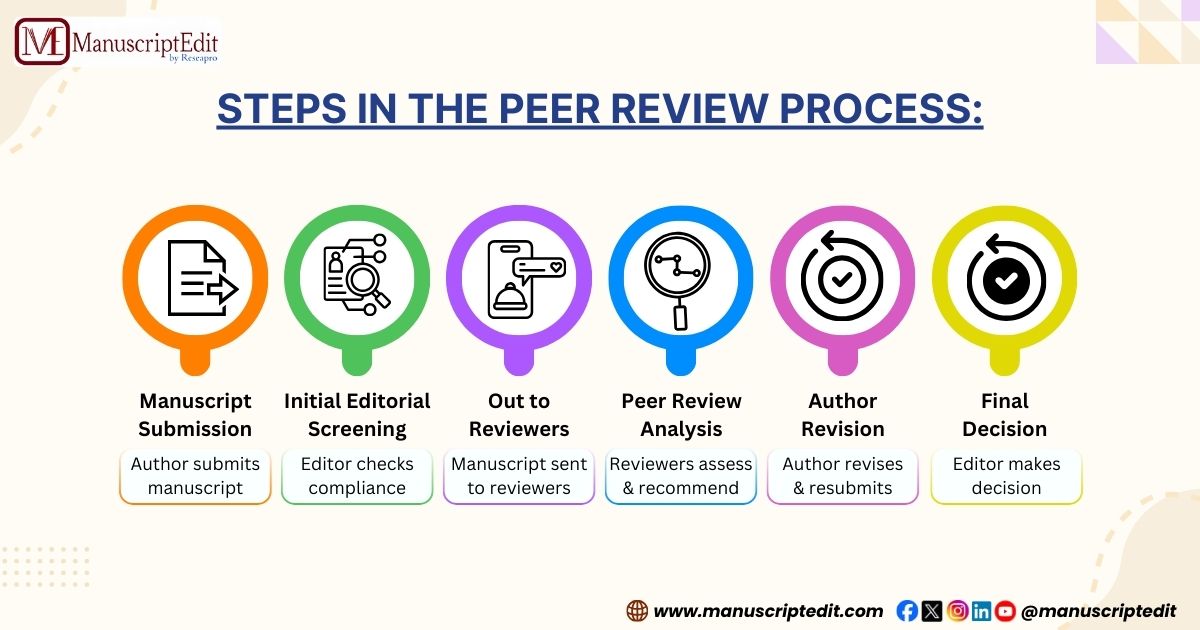|
Getting your Trinity Audio player ready...
|

Peer review, in academia, forms the backbone of scientific publications where only high-quality, credible research makes it onto the pages of prestigious journals. If you are a publishing researcher, it is very important to understand how peer review works—not just to get your work published but also to contribute to the advancement of science.
Below, we go deep into the details of academic peer review by offering tips for authors and discussing modern trends in how research is assessed today. Whether you’re a first-time or seasoned author, this guide will walk you through the process of manuscript review with confidence.
What is the Process of Peer Review?
Peer review is a process where other experts in the same field go over in detail the value, validity, and significance of a manuscript before its publication. The tough assessment selects only such research that holds value to the academic community and meets standards set by the respective journal.
Steps in the Peer Review Process:

- Manuscript Submission: The author submits a manuscript to the journal.
- Initial Editorial Screening: The editor first screens the manuscript to be in compliance with the scope of the journal submission.
- Out to Reviewers: The editor forwards the manuscript to the peer reviewers for review.
- Peer Review Analysis: The reviewers go through the manuscript for accuracy, methodology, originality, and clarity, and then recommend the manuscript for acceptance, revision, or rejection.
- Author Revision: The author revises the manuscript in consideration of the reviewer’s comments and resubmits.
- Final Decision: The editor makes the final decision after considering the revised manuscript and the recommendations of the reviewers.
Types of Peer Review:
To preserve this integrity in the research, different journals use different kinds of peer review. Commonly used formats include:
- Single-Blind Review
In this format, the reviewers remain anonymous but are known to the authors. This serves to protect the reviewers from any external pressures; it can introduce bias against authors in some cases. - Double-Blind Review
In a double-blind peer review, the authors and reviewers are anonymous. This system is usually considered the most objective form because it reduces possible biases related to the identity of the author, institution, or reputation. - Open Peer Review
Open peer review refers to when the authors and reviewers know one another. The advantage is greater transparency, but this sometimes leads to more reserved feedback because the reviewers are lightening their criticism. - Post-Publication Peer Review
In this model, the research is published first, and then the academic community evaluates it. The approach has found considerable traction in recent times, most especially in fields like medicine and biology. This is most true, especially in situations where timely dissemination of findings is very critical—for example, during the COVID-19 pandemic.
Recent Trends in the Peer-Review Process:Â
The landscape of academic peer review is ever-changing. Let’s take a look at some of the latest happenings factoring into how research gets vetted and published:
- AI and Automation of Peer Review
The rise of AI is changing peer review. AI tools already check manuscripts for plagiarism, quality of language, and adherence to specific guidelines about form and preparation by the journal. These tools accelerate the initial editorial review and free human reviewers to evaluate the scientific merit of the research.
Artificial intelligence can never replace human judgments but rather works as a strong tool to lessen the administrative workload by improving efficiency in the review process. - Growth of Open Peer Review
With a growing trend of transparency in academia, more journals are leaning towards open peer review. This approach not only discloses the identity of the authors and their reviewers but also, quite often, publishes the review reports along with the article. It is all about accountability and reducing bias in the review process.
Journals like Nature Communications and F1000Research are at the forefront of open peer review, making the process transparent and collaborative. - Preprints and Rapid Publication
There is a growing interest in preprint servers like arXiv and bioRxiv. Preprints are the forms of articles that are shared before they go through the conventional process of peer review. This trend had been particularly marked during periods of public health emergencies, such as the COVID-19 pandemic, where timely dissemination of research became imperative.
On the other hand, such rapid dissemination of non-peer-reviewed data raises a number of questions regarding the quality and reliability of preprint findings. Researchers have to balance the need for speed with the need for accuracy. - Reviewer Fatigue
Along with the increasing submissions, many reviewers share a growing trend for reviewer fatigue; hence, it is considerably more challenging for journals to acquire qualified reviewers. To increase the number of reviews and the quality thereof, some journals provide incentives, like recognition on platforms like Publons or ORCID, or even financial rewards. - Promoting Diversity in Peer Review
There is now more of a drive to make the process of peer review diverse and fair. The panels for peer review have, throughout the years, been demographically and geographically biased. Today, journals consciously work towards including reviewers from a wide array of backgrounds, enhancing the fairness of the reviews.
Challenges in the Process of Peer Review:Â
While peer review is considered to be at the heart of scholarly publishing, it does not come without its own set of issues:
- Peer-Review Bias
Notwithstanding full conscious effort, it is hard to avoid all forms of bias in peer review. The bias can relate to the gender of the author, institution, or nationality. Double-blind reviews reduce this problem to a certain extent; however, journals must remain vigilant against any form of unfairness and inequity. - Reviewer Fatigue
Greater submissions mean more work for the reviewers, who may respond late or hurriedly or may struggle to find qualified experts. Some journals are considering innovative ways to incentivize reviewers, with profiles on sites such as Publons or ORCID. - Quality Accountability in Review
Anonymous peer review may result in unduly harsh or non-constructive feedback. Open peer review induces reviewers to give more reflective and balanced criticism and is considered a solution.
Navigating Peer Review as an Author:
Peer review can be daunting. Here are some peer review tips for researchers:
- Selecting the Correct Journal
Ensure the study fits the journal’s submission guidelines and scope. Submitting to the right journal significantly increases the likelihood of acceptance. - Polish Your Manuscript
Ensure that your manuscript is properly organized, grammatically correct, and well-written. Manuscript preparation services like ManuscriptEdit can help refine your submission. - Respond Thoughtfully to Reviewers
When receiving feedback, take the time to respond thoroughly. Address each comment with revisions or reasons why some changes weren’t possible. - Patience and Professionalism
High-impact journals have long review times, so patience is important. If you haven’t heard back within the expected time, it’s okay to follow up politely with the journal editor.
Peer Review: What’s Its Future?
Looking ahead, the future of peer review will be determined by advances in AI, increasing transparency, and the need for speed and accessibility. Its mission remains to ensure rigorous, accurate, and meaningful contributions from published research.
Conclusion:Â
Peer review is central to academic publishing. Staying prepared for the changes brought by new technologies and continuing challenges makes it easier to navigate the process. Whether you’re submitting your first or hundredth manuscript, managing the peer review process is key to publication success.



